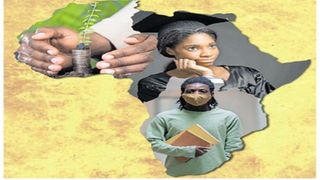
The Covid-19 pandemic has exposed and exacerbated the systemic deficiencies and inequalities in health care systems, economies, businesses and educational institutions around the world.
| File | Nation Media GroupEducation
Premium
What ails African universities and approaches that hold the cure
The Covid-19 pandemic has exposed and exacerbated the systemic deficiencies and inequalities in health care systems, economies, businesses and educational institutions around the world. African universities have been particularly affected - what does this portend for their future and for the production, consumption and dissemination of scholarly knowledges?
Universities face various overlapping futures ranging from restoration, to evolution, to transformation. These interlinked scenarios encompass every aspect of university affairs, from the modalities of teaching and learning, financial models, leadership skills and institutional governance systems to modes of external engagements.
In this context, it is critical to interrogate the desirable transformative trajectories for African universities. Constructing new futures for African universities and knowledge economies entails institutional, intellectual, and ideological struggles and negotiations as well as different ways of studying and assessing the value proposition of universities not only for students and other internal stakeholders, but also for African societies and diasporas in their complex national and transnational dimensions, articulations, and intersections.
In March 2015 the first African Higher Education Summit held in Dakar, Senegal, identified the challenges and opportunities for African universities in the realisation of the African Union’s Agenda 2063, which remains as pressing as ever.
Education is indispensable for the realisation of Agenda 2063 in so far as promoting integrated, inclusive, innovative, structural, and sustainable development requires building strong human capital, research systems, and robust collective identities and civic values. The Dakar Summit sought “to create a continental multi-stakeholders’ platform to identify strategies for transforming the African higher education sector” in pursuit of Agenda 2063.
In 1959, on the verge of Africa’s “year of independence” in 1960 when 17 countries achieved their freedom from colonial rule, there were only 76 universities across Africa, mostly concentrated in South Africa, Egypt, and parts of West Africa. The number rose to 170 in 1970, 294 in 1980, 446 in 1990, 784 in 2000, 1,431 in 2010, and 1,682 in 2018. Enrolments rose from 0.74 million in 1970 to 1.7 million in 1980, 2.8 million in 1990, 6.1 million in 2000, 11.4 million in 2010, and 14.7 million in 2017.
Higher education
As rapid as this growth was, Africa remained with the lowest levels of higher education institutions and tertiary enrolments, which stood at 8.9 percent of the world’s 18,772 higher education institutions (Asia had 37 percent, followed by Europe with 21.9 percent, North America 20.4 percent, Latin America and the Caribbean 12 percent). Forty-five percent of the African students were in Northern Africa.

A virtual meeting in progress.
Enrolment ratios tell the story differently. In 2017, the world’s average enrolment ratio was 37.88 percent, compared to 8.98 percent in sub-Saharan Africa and 33.75 percent in Northern Africa. Kenya’s stood at 11.66 percent in 2016. Put simply, not enough Africans are going to university. The outbreak of the coronavirus pandemic in early 2020 forced universities around the world to confront unprecedented challenges that simultaneously exposed and exacerbated existing deficiencies and dysfunctions. Six stand out.
Remote learning
First is transitioning from face-to-face to remote teaching and learning using online platforms. Second, managing severely strained finances. Third, ensuring the physical and mental health of students, faculty and staff. Fourth, reopening campuses as safely and as effectively as possible. Fifth, planning for a sustainable post-pandemic future.
Sixth, contributing to the capacities of government and society in resolving the multiple dimensions of the Covid-19 pandemic. Universities in Africa were among the most affected and least able to manage the multi-pronged crises because of their pre-existing capacity challenges that centered on 10 dimensions, namely, institutional supply, financial resources, human capital, research output, physical and technological infrastructures, leadership and governance, academic cultures, quality of graduates, patterns of internationalisation and global rankings.
Some of these institutional deficits directly affected the ability of universities to manage the pandemic and to plan for the post-pandemic future. Most crucial are the technological, financial, and research capacities, and the state of institutional cultures and leadership.
The digital divide was evident among and within countries and institutions in terms of access to broadband, electronic gadgets, data costs, digital literacy and preparedness for administrators, faculty, staff and students. Digital inequalities reflected and reinforced the prevailing differentiations of class, gender, age, race, location, disability, and other social markers.
The technological challenges were compounded by worsening financial strains. University revenues from auxiliary services plummeted following campus closures and they were forced to undertake severe budget cuts including job furloughs, reductions in salaries and pensions, suspension of capital projects and renegotiation of service contracts. Some stared at the brink of bankruptcy and permanent closure. The financial crisis was of course not confined to African or developing countries. It was a global phenomenon.

University students with their teacher during a creative workshop.
The pandemic not only put pressure on African universities’ finances and operations, but also raised the stakes for research and policy interventions. They were expected to undertake biomedical and socio-economic research to manage the pandemic.
Some universities produced hygiene products and personal protective equipment including hand sanitisers, masks, ventilators, testing kits and robots for delivery of food and medicines to patients.
Others undertook research on the epidemiology of the coronavirus and biomedical treatments and the socioeconomic impacts of the pandemic, provided advisory services to government, developed software to monitor the pandemic’s spread and sought to raise awareness and provide psychosocial support to their constituents and the wider society.
However, most African universities and firms stood on the sidelines as their societies waited for the development of vaccines in the global North, China, and India. At best, a few collaborated with overseas universities, research establishments and networks, and hosted clinical trials, although they were “unable to secure a fair pricing agreement.”
What are our universities, governments and industries doing to serve and save themselves besides stretching their hands and praying for salvation from the rich world while indulging in perennial and petty, but often vicious, national and institutional politics?
Covid-19 should be a wake-up call to African universities and countries to strengthen their research capacities, science, technology and innovation systems, manufacturing capabilities, and inter-institutional and interdisciplinary collaboration through existing consortia, such as the African Research Universities Alliance and new ones.
A crisis, as the saying goes, is the flip side of opportunity. The bigger the crisis, the more profound the lessons to be learned and the greater the imperatives for transformation. African universities are likely to pursue three scenarios.
The restore scenario will be focused on reclaiming the institution's pre-pandemic financial health and operations while the evolve scenario applies to “institutions that will choose to incorporate the impact and lessons of the pandemic into their culture and vision,” and under the transform scenario institutions will “use the pandemic to launch or accelerate an institutional transformation agenda.”
For some universities, what is at stake is survival, for others stability and for many sustainability. Institutional survival is a precondition for stability which is essential for sustainability. Confronting the entire higher education sector is the question of its raison d’être, its value proposition in a digitalised world accelerated by COVID-19. Building strong institutional cultures requires adherence to seven critical values.
Diversity
First, is academic freedom, freedom of inquiry for faculty and students and the procedural and substantive autonomy of institutions. Second is shared governance, which refers to the participation and demarcation of rights and responsibilities in decision making between faculties, management, and governing boards. Typically, faculty is expected to exercise authority on academic matters such as the curriculum, instruction, and degree requirements.
Third is diversity, equity and inclusion. Given their critical role as pathways for social mobility and leadership across all sectors, universities are increasingly expected to promote diversity, equity and inclusion at all levels and for all their constituencies.
Fourth, civility and collegiality. The academic bully culture, as Darla Twale and Barbara De Luca call it in their book by that title has grown. Some call it academic mobbing. Incivility and intolerance in universities has several manifestations. Student and faculty incivility are also fueled by a rising sense of entitlement, consumerist attitudes, emotional immaturity, stress, racism, tribalism, sexism, ageism, xenophobia, social media and other pervasive social and institutional ills.
Fifth, universities must maintain their role as generative spaces in the rigorous search for truth. The “posts” and the movement for decolonising knowledge has vigorously and rightly contested the epistemic architecture and metanarratives of the Eurocentric academy and its hegemonic knowledges.
Sixth, effective communication is essential for building cohesive communities out of the university’s disparate constituencies that have divergent interests, priorities, and preferences. Internally, there are students, faculty, staff, administrators and governing boards, and externally prospective students and employees, alumni, parents, government, regulatory agencies, competitors, institutional partners, donors, the media and general public.
Seventh, embracing social responsibility is vital for universities to eschew institutional naval gazing for the higher purpose of social impact that can mobilise internal and external stakeholders. Universities are well placed to provide evidence based knowledge, solutions and innovations for society. Financial sustainability requires pursuing seven strategies as well.
First, public funding for higher education needs to be raised substantially if African countries are serious about improving the quality of human capital so essential for integrated and innovative sustainable development, and for them to turn the demographic explosion into a dividend rather than a disaster.
Second, establishing differentiated tuition pricing and targeted student aid. Besides increasing spending per student, which is the lowest in the world, African governments and universities must develop targeted free or low tuition for the neediest students who qualify for university studies, improve student loan recovery schemes, and make them income contingent. Private universities can do this through internal effective and sustainable student aid policies and external scholarships.
Third, exercising prudent financial management. Financial challenges facing higher education institutions require the adoption of more sophisticated and transparent budgeting models to ensure efficient utilisation of limited resources. The spectre of corruption that undermines the finances of some universities should also be ruthlessly tackled.
Auxiliary services
Fourth, diversifying revenue streams. African universities could increase income from auxiliary services, undertaking entrepreneurial activities including consultancies, offering executive programmes, and establishing enterprises that leverage their expertise and innovations, consistently bringing in large research grants, and raising philanthropic donations.
Fifth, creating institutional mergers. Many of the public and private universities that have mushroomed in the last two decades are simply glorified high schools. For economies of scale in the higher education sector, mergers are imperative even for the fiercely independent and often thinly disguised for-profit private universities.
Sixth, forging robust inter-institutional collaborations. University consortia will become increasingly necessary to promote quality education, facilitate cost sharing and bargaining in the procurement of expensive technological infrastructures, instructional materials, talent development, and to facilitate the mobility of students, faculty, credit transfer, and the development of inter-institutional innovative programs and practices.
Seventh, strengthening external partnerships with other higher education institutions and non-academic sectors and organisations. Old patterns of asymmetrical internationalisation must be replaced by strategic inclusion, mutuality, and co-creation of activities and initiatives and humanising internationalisation by abandoning exploitation of international students who tend to be treated as “cash cows”.
Higher education is too important for Africa’s future to be held captive to haphazard interventions and superficial reforms. What is needed is fundamental transformation thanks, in part, to the massive disruptions of COVID-19. Studies show the return on investment for education are much higher for society and individuals than any other form of investment.
This is an abridged version of a presentation at a webinar at USIU-Africa on May 26, 2021.
Prof Paul Tiyambe Zeleza is the Vice Chancellor and professor of Humanities and Social Sciences, United States International University-Africa.





